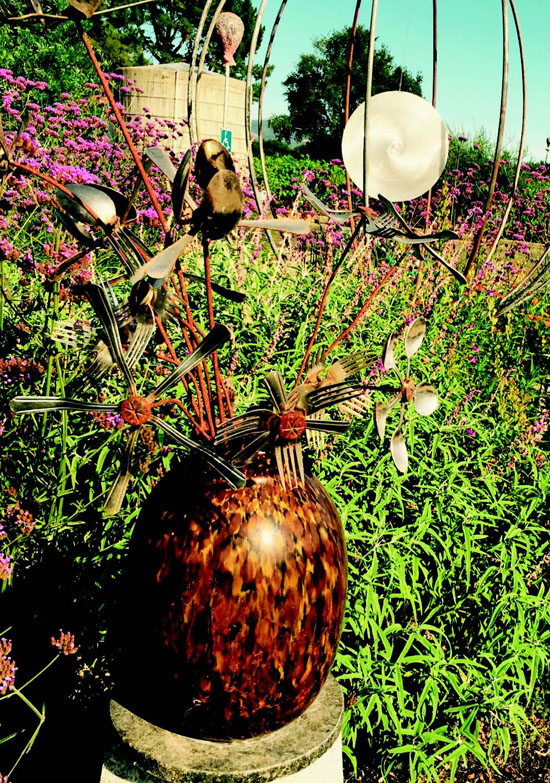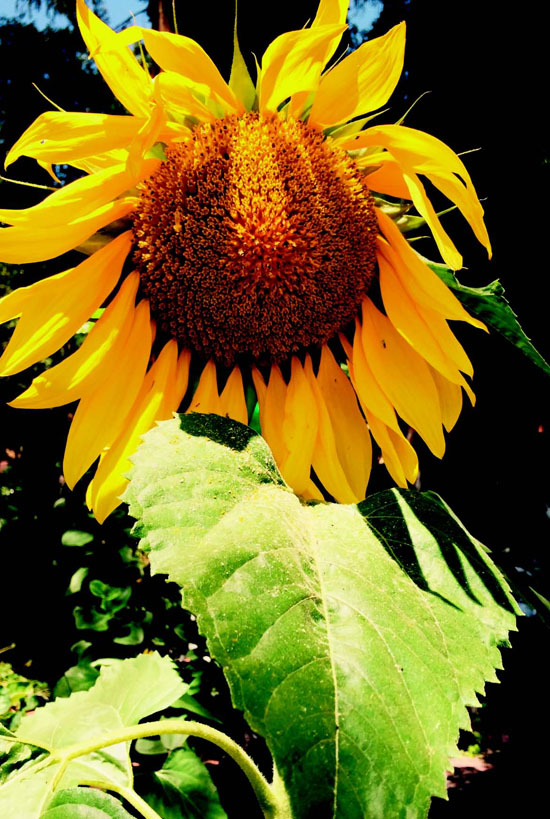 | | | A swath of marigolds lights up a soothing garden area. Photos Cynthia Brian | | | | | | "Though we travel the world over to find the beautiful, we must carry it with us or we find it not." ~ Ralph Waldo Emerson
 August is nearly upon us, the most traveled month of the year. Before the craziness of the school year begins, families are rushing to enjoy the last of the lazy, hazy days of summer. Summer has sped by and before we know it, autumn will be here. The drought has been the conversation du jour at every gathering I've attended. There's nothing we can do to prevent a drought, but there are some strategies we can enact to help minimize the effect it has on our landscapes. As our healthy green foliage droops and wilts, leaves develop crispy brown edges, flowers fade quickly, and everything grows more slowly. The weakening of our plants encourages insect infestation and disease. Before we embark on additional August adventures, it's important to prepare your garden for your absence. This month's gardening guide includes a few tips so that you can carry your "beautiful" with you wherever you go.
August is nearly upon us, the most traveled month of the year. Before the craziness of the school year begins, families are rushing to enjoy the last of the lazy, hazy days of summer. Summer has sped by and before we know it, autumn will be here. The drought has been the conversation du jour at every gathering I've attended. There's nothing we can do to prevent a drought, but there are some strategies we can enact to help minimize the effect it has on our landscapes. As our healthy green foliage droops and wilts, leaves develop crispy brown edges, flowers fade quickly, and everything grows more slowly. The weakening of our plants encourages insect infestation and disease. Before we embark on additional August adventures, it's important to prepare your garden for your absence. This month's gardening guide includes a few tips so that you can carry your "beautiful" with you wherever you go.
 � APPLY mulch in a layer of two to three inches deep. Mulching your garden will keep the soil cooler while keeping the moisture near the roots longer. Plus mulch shields plants from the direct sunlight.
� APPLY mulch in a layer of two to three inches deep. Mulching your garden will keep the soil cooler while keeping the moisture near the roots longer. Plus mulch shields plants from the direct sunlight.
 � RUN soaker hoses under the mulch to maximize water savings. Soaker hoses keep the foliage dry, preventing common fungal diseases while reducing evaporation from the heat.
� RUN soaker hoses under the mulch to maximize water savings. Soaker hoses keep the foliage dry, preventing common fungal diseases while reducing evaporation from the heat.
 � REPAIR leaks in hoses and check your irrigation system before you go on holiday. A single broken sprinkler head will waste copious amounts of water and you won't be happy with an outrageous water bill upon your return.
� REPAIR leaks in hoses and check your irrigation system before you go on holiday. A single broken sprinkler head will waste copious amounts of water and you won't be happy with an outrageous water bill upon your return.
 � WATER deeply before you leave on your trip. Most plants need an inch of water a week to stay healthy. Set sprinkler timers accordingly.
� WATER deeply before you leave on your trip. Most plants need an inch of water a week to stay healthy. Set sprinkler timers accordingly.
 � DEADHEAD annuals. When your zinnias, marigolds, dahlias and petunias start getting leggy or are spent, clip off the blooms. Plants exert extra energy to produce seeds. By deadheading, you'll get more blooms!
� DEADHEAD annuals. When your zinnias, marigolds, dahlias and petunias start getting leggy or are spent, clip off the blooms. Plants exert extra energy to produce seeds. By deadheading, you'll get more blooms!
 � WEED, weed, weed. Even in a drought, weeds sprout up robbing your precious plants of the water they require. Be an extreme weeder and pull out anything that doesn't belong in your garden. Your other plants will thank you.
� WEED, weed, weed. Even in a drought, weeds sprout up robbing your precious plants of the water they require. Be an extreme weeder and pull out anything that doesn't belong in your garden. Your other plants will thank you.
 � MOVE container plantings to the shade of an overhang as they demand more frequent watering when days are warm.
� MOVE container plantings to the shade of an overhang as they demand more frequent watering when days are warm.
 � THINK about planting a more drought tolerant garden in the fall. If you need to fill in your landscape, consider native grasses, yarrow, and a plethora of beautiful succulents.
� THINK about planting a more drought tolerant garden in the fall. If you need to fill in your landscape, consider native grasses, yarrow, and a plethora of beautiful succulents.
 � PRUNE suckers growing from trees and roses as these zap the strength of the mother plant and may kill the rootstock.
� PRUNE suckers growing from trees and roses as these zap the strength of the mother plant and may kill the rootstock.
 � PICK peaches, nectarines and apples as they ripen. Place a bowl on the counter, pack a few in your backpack, refrigerate the extras, or make simple cobblers, pies and crisps, even on camping trips.
� PICK peaches, nectarines and apples as they ripen. Place a bowl on the counter, pack a few in your backpack, refrigerate the extras, or make simple cobblers, pies and crisps, even on camping trips.
 � INSTALL a dry creek or river rock bed. Your dry creek will be pretty and useful all year long. When winter rains come, the water will be directed to areas you wish.
� INSTALL a dry creek or river rock bed. Your dry creek will be pretty and useful all year long. When winter rains come, the water will be directed to areas you wish.
 � GROW sunflowers not only for the ornamental or decorative value, but for the nutritious seeds that birds adore. Sunflowers can also bring a smile to your face.
� GROW sunflowers not only for the ornamental or decorative value, but for the nutritious seeds that birds adore. Sunflowers can also bring a smile to your face.
 � ZERO-SCAPE, actually xeriscape, to conserve water while benefiting from a beautiful garden. The benefit of xeriscaping is a low-maintenance garden that is drought resistant, water conserving, with a habitat for wildlife.
� ZERO-SCAPE, actually xeriscape, to conserve water while benefiting from a beautiful garden. The benefit of xeriscaping is a low-maintenance garden that is drought resistant, water conserving, with a habitat for wildlife.
 � DRY FARM your tomatoes and grapes. The vines may look terrible, but the fruit will be filled with flavor, richness and color.
� DRY FARM your tomatoes and grapes. The vines may look terrible, but the fruit will be filled with flavor, richness and color.
 � LEAVE your grass clippings on the lawn to act as recycling mulch. Make sure your mower height is set to three inches high, as high mown grasses can better withstand drought conditions. When winter rains arrive, lawns will bounce back.
� LEAVE your grass clippings on the lawn to act as recycling mulch. Make sure your mower height is set to three inches high, as high mown grasses can better withstand drought conditions. When winter rains arrive, lawns will bounce back.
 � TRASH can become artistic treasure in the garden. Can you be creative with repurposed odds and ends? Give it a try. The recycle bin is nearby when ingenuity fails.
� TRASH can become artistic treasure in the garden. Can you be creative with repurposed odds and ends? Give it a try. The recycle bin is nearby when ingenuity fails.
 � PLANT drought tolerant perennials such as pentstemon, agastache, yarrow, blanket flower, lamb's ear, Echinacea, lavender, Russian sage and sedum.
� PLANT drought tolerant perennials such as pentstemon, agastache, yarrow, blanket flower, lamb's ear, Echinacea, lavender, Russian sage and sedum.
 � DRY herbs before they go to seed. Cilantro (coriander), dill, fennel, parsley and mint are welcome ingredients in winter cuisine when the fresh herbs are not available.
� DRY herbs before they go to seed. Cilantro (coriander), dill, fennel, parsley and mint are welcome ingredients in winter cuisine when the fresh herbs are not available.
 � PERUSE bulb catalogues to determine what you want to order or locally buy to plant in the fall. Narcissus, tulips, daffodils, hyacinths, anemones and more will be available in a month.
� PERUSE bulb catalogues to determine what you want to order or locally buy to plant in the fall. Narcissus, tulips, daffodils, hyacinths, anemones and more will be available in a month.
 � WATCH out for errant sparks from fire pits, barbecues, candles, and tiki torches. It's fire season all year! Make sure the perimeter of your house is brush and weed free providing a safety zone and firebreak.
� WATCH out for errant sparks from fire pits, barbecues, candles, and tiki torches. It's fire season all year! Make sure the perimeter of your house is brush and weed free providing a safety zone and firebreak.
 � INVOLVE your children in maintaining the vegetable garden. They will want to eat what they grow as summer snacks. Once school commences, they'll be proud to pack a healthy lunch that they grew themselves.
� INVOLVE your children in maintaining the vegetable garden. They will want to eat what they grow as summer snacks. Once school commences, they'll be proud to pack a healthy lunch that they grew themselves.
 � SAVE seeds from marigolds, hollyhocks, cosmos and other annuals as their summer life span ends. Next spring, plant these seeds for another display of splendor.
� SAVE seeds from marigolds, hollyhocks, cosmos and other annuals as their summer life span ends. Next spring, plant these seeds for another display of splendor.
 � SAVOR the sweet days of August whether you are at home or away. Lounge by the pool, curl up on the chaise with a great book, water ski, visit a botanical garden, hike in the hills, or roast some marshmallows! Have fun!
� SAVOR the sweet days of August whether you are at home or away. Lounge by the pool, curl up on the chaise with a great book, water ski, visit a botanical garden, hike in the hills, or roast some marshmallows! Have fun!
 Carry your beautiful world with you. Mother Nature rules!
Carry your beautiful world with you. Mother Nature rules!

 Happy Gardening and happy growing.
Happy Gardening and happy growing.

|



